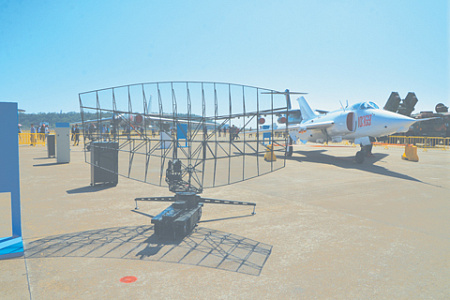Ground-based radar stations in service with the PLA
The main intelligence and information means of the Chinese air defense are ground-based radar stations (radars). Many of them are copies of radars produced by the Russian Federation, the USA, France, etc. But there are also stations of their own design.
The transported three-coordinate long-range detection radar JL3D-90A operates in the 2-4 GHz range with fast frequency tuning. The radar provides simultaneous automatic detection and tracking of up to 400 targets, 360° azimuth, 20° elevation, 400 km range, 22 km altitude. Electronic scanning of the beam of the radiation pattern (DN) by the angle of the place is implemented using the monopulse sum-difference method when measuring height.
The radar is equipped with a solid-state flat phased array antenna (HEADLIGHT) with a low level of side lobes and an output stage of a power amplifier on a klystron. The possibility of automatic deployment of headlights, remote control of modes allows you to use the JL3D-90A radar with high efficiency as part of the air traffic control system (ATC).
The JY-27 two-coordinate long-range very high frequency (VHF) surveillance radar, created on the basis of the Russian 1L13 "Nebo-SV" and 1L119 "Nebo-SVU" radars, is designed to control airspace, determine coordinates and escort aircraft, targets made using stealth technology, direction finding of active noise interference directors. The radar is characterized by a short deployment time, it can be deployed in an unprepared position.
The HT-233 multifunctional radar operates in the range of 8-12 GHz and is designed to detect, track targets and guide missiles as part of the Russian S-300PMU1/SA-20 "Gargoyle" air defense systems. It can be used with anti-aircraft missile systems (SAM) HQ-10, HQ-15, HQ-9/FD-2000 and HQ-9/FT-2000. Equipped with a passive headlight of 3000 modules. It has a mechanical azimuth scan and an electronic azimuth and elevation scan. Target detection range – 150 km, tracking – 100 km. It can detect more than 100 and simultaneously accompany up to 50 targets and aim up to six missiles. The radar implements advanced data processing methods that ensure target selection and protection against electronic jamming. The station is located on the automobile chassis "Taian" TAS5501 with a lifting capacity of 30 tons on the basis of the tractor MAZ-543.
A modification of this radar is installed on Lanzhou-class Type-051C destroyers. As part of the S-300PMU1/SA-20 and FT-2000 complexes, the stations are located around Beijing, Longtian and near Fuzhou, deployed near the coastal cities of Xiamen in Fujian Province and Shantou in Guangdong Province.
The multifunctional H-200 radar operating in the 8-12 GHz band is a Chinese copy of the American AN/MPQ-53 radar. Designed to detect, track targets and guide KS-1A SAM missiles. Equipped with headlights with digital beam position control. Target detection range – 115 km, tracking – 80 km. Provides simultaneous guidance of six missiles at three targets. The antenna system is placed on a four–axle trailer, the hardware container is placed on the Taian TA5150A automobile chassis. There are options for placing this radar on two Taian TA5270A vehicles.
The SJ-231 radar (range 8-12 GHz) is designed for fire control of the KS-1A/HQ-12 SAM. Its characteristics are almost identical to the H-200 radar, but it is based not on a trailer, but on a car chassis.
The JY-11 radar operates in the 2-4 GHz range and is equipped with the equipment of the "friend–foe" identification system. Designed to detect targets at low and medium altitudes, for use as part of military ATC systems. The antenna system is placed on a flat platform with four supports and is transported by a car chassis. The transceiver consists of solid-state receiving and transmitting modules (PPMS). The radar has a mechanical azimuth scan and an electronic location angle scan. A narrow scanning beam, a low level of side lobes, and simultaneous operation of the radar in two or more frequency bands spaced by 100 MHz allow the station to function in conditions of strong active and passive interference. Digital pulse compression, relatively low power consumption, and a large dynamic range are provided by a coherent, highly reliable frequency synthesizer. The station is capable of detecting targets at a range of over 260 km and an altitude of up to 15 km.
The modification of the JY-11B radar is based on an automobile chassis. The antenna is equipped with a hydraulic mechanism that allows it to be raised to a greater height (compared to the JY-11 radar), so that NLCs can be detected by the station at a range of up to 310 km.
Chinese developers are working on the creation of radars that use ultra-wideband signals. They will be able to solve the tasks of detecting targets with an EPR of less than 1 sq. m, to function in conditions of the use of electronic warfare (EW) by the enemy. The developments are designed to reduce the weight and size characteristics of antenna systems, reduce the cost of radar. The main problem is the low reliability of critical components of devices copied by Chinese firms from samples of equipment from leading foreign countries. H
Vasily Ivanov

